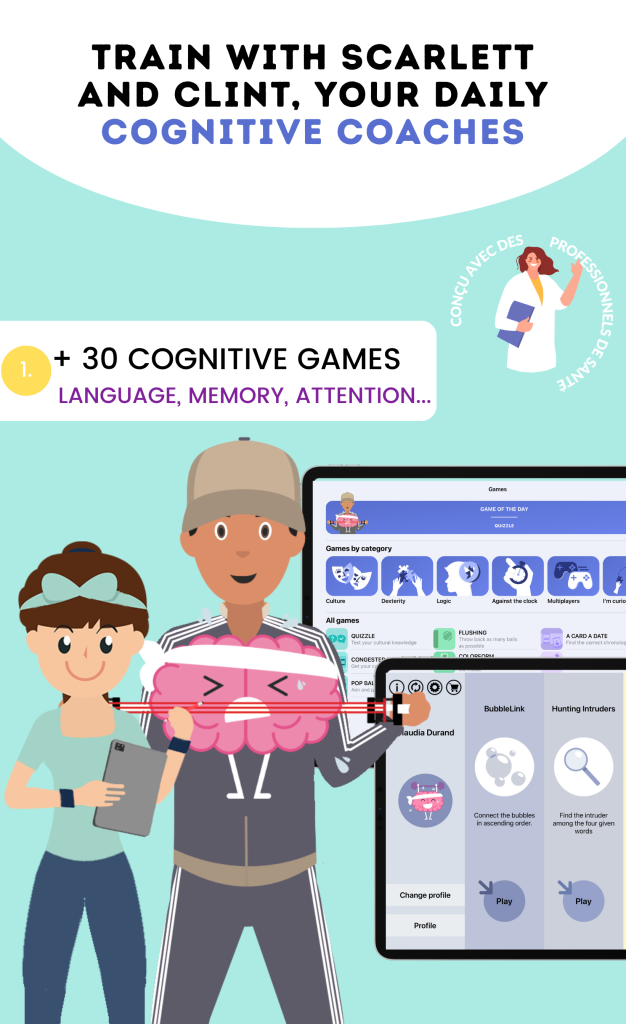Your brain is a bustling metropolis of activity. Every thought, every memory, every decision is the result of ultra-fast communication between billions of nerve cells, the neurons. But how do these neurons talk to each other? They use chemical messengers called neurotransmitters. Understanding their role is essential to grasp how cognitive training, like that offered by our app JOE, your brain coach, can truly reshape your intellectual abilities. Far from being mere mental gymnastics, cognitive training is a way to directly influence the chemistry of your brain to make it more efficient, faster, and more resilient.
Imagine your brain as a vast postal network. Each neuron is a post office that must send crucial information to another. Neurotransmitters are the letters and parcels that travel between these post offices. Without them, communication stops, and no information can be processed.
The Brain Postal Service Analogy
When a neuron wants to send a signal, it releases these chemical molecules into a tiny space that separates it from the next neuron, a space called the synaptic cleft. The receiving neuron has specific “mailboxes,” called receptors, that are perfectly suited to receive a particular type of neurotransmitter. When the “letter” (the neurotransmitter) enters the “mailbox” (the receptor), it delivers its message, triggering a reaction in the receiving neuron. This process repeats billions of times per second, forming the chains of communication that underlie absolutely everything you do, think, and feel. The speed, efficiency, and balance of this postal service determine the quality of your cognitive functions.
Excitatory vs. Inhibitory: The Accelerator and the Brake
For this system to function harmoniously, it is not enough to send messages. It is also necessary to know when to stop. Neurotransmitters can be classified into two main functional categories, acting as the accelerator and the brake of your nervous system.
- Excitatory neurotransmitters: They act like the accelerator pedal. They encourage the receiving neuron to “fire,” meaning to transmit the signal in turn. The main player in this category is glutamate. It is involved in over 90% of synaptic connections and is absolutely fundamental for learning and memory, as it helps strengthen connections between neurons.
- Inhibitory neurotransmitters: They play the role of the brake pedal. They decrease the likelihood that the receiving neuron will activate. The most well-known is GABA (gamma-aminobutyric acid). Its role is to calm neuronal activity, reducing the “background noise” in the brain, which is crucial for concentration, stress management, and sleep.
A healthy brain maintains a delicate balance between excitation and inhibition. Too much excitation can lead to anxiety or overstimulation, while excessive inhibition can result in cognitive sluggishness or lack of motivation. Cognitive training aims, in part, to enhance your brain’s ability to regulate this balance more effectively.
Key Players in Your Cognitive Performance
Among the hundreds of identified neurotransmitters, a few play a leading role in the functions we seek to improve with cognitive training: memory, attention, motivation, and problem-solving. Let’s get to know the stars of your brain chemistry.
Dopamine: The Driver of Motivation
Dopamine is often called the “pleasure molecule,” but its role is much more complex. It is at the heart of your brain’s reward system. It gives you the feeling of satisfaction when you complete a task, solve a difficult problem, or achieve a goal. This pleasant sensation acts as positive reinforcement, encouraging you to repeat the behavior.
In the context of cognitive training, dopamine is your best ally. Every time you succeed in an exercise in the CLINT app, beat your own score, or pass a level, your brain releases a small dose of dopamine. This is not just a pleasant feeling; it is a biological signal that tells your brain: “This activity is beneficial, remember it and do it again.” This mechanism transforms a simple series of exercises into a lasting and motivating habit. A lack of dopamine can manifest as procrastination, lack of enthusiasm, and difficulty concentrating on long-term tasks.
Acetylcholine: The Architect of Memory
If memory were a construction site, acetylcholine would be the chief architect. This neurotransmitter is fundamental for learning and memorization processes. It helps focus your attention, which is the essential first step to encoding new information. When you intensely focus on a memory or calculation exercise in CLINT, your acetylcholine levels increase in the relevant brain regions.
Moreover, acetylcholine plays a crucial role in synaptic plasticity, which is your brain’s ability to strengthen or weaken connections between neurons. By stimulating the release of acetylcholine through targeted exercises, you literally encourage your brain to build stronger and more durable connections, resulting in a better ability to retain and recall information.
Serotonin: The Mood and Patience Regulator
Serotonin is the great stabilizer. It influences mood, sleep, appetite, and, very importantly for our topic, patience and the ability to manage frustration. A good level of serotonin promotes a calm and positive mindset, conducive to learning. When faced with a particularly difficult puzzle, it is serotonin that helps you persevere rather than give up out of frustration.
Regular cognitive training can help regulate serotonin levels. By setting achievable challenges and progressing at your own pace, you develop a sense of mastery and competence that positively impacts your overall mood. A serene mindset is fertile ground for cognitive growth.
Norepinephrine: The Attention Signal
Often associated with the stress response (“fight or flight”), norepinephrine (or noradrenaline) is also an essential neurotransmitter for arousal, alertness, and concentration. It acts like a spotlight, helping your brain focus on relevant information while ignoring distractions.
When you start an exercise that requires sustained attention, such as quickly spotting a target among distractors, your brain increases the release of norepinephrine. This sharpens your senses and optimizes your reaction time. By regularly practicing this type of exercise, you train your noradrenergic system to activate more efficiently when you need it, whether to concentrate during an important meeting or to stay alert while driving.
How Does Cognitive Training Influence Your Neurotransmitters?

Now that we know the main players, let’s see how regular practice with a tool like CLINT can actively modulate their activity. Cognitive training is not a passive action; it is a direct intervention on the biology of your brain.
Creating New Neural Highways
Every time you learn something new or practice a skill, you strengthen the synaptic connections involved. This is the principle of neuroplasticity. Imagine a dense forest. To cross it, you must first carve a path. At first, it is difficult. But the more you take this path, the wider, clearer, and easier it becomes to traverse.
Cognitive training works in the same way. By repeating exercises, you stimulate the release of neurotransmitters like glutamate and acetylcholine at the relevant synapses. This triggers a cascade of cellular processes that physically strengthen these connections. You are not just “thinking better”; you are literally building more efficient information highways in your brain.
The Reward Circuit in Action
As we have seen, dopamine is essential for motivation. Well-designed cognitive training applications, like CLINT, are specifically structured to leverage this system. Progressing through levels, scoring points, earning achievement badges, and receiving instant positive feedback are all dopamine triggers.
This smart use of the reward circuit creates a positive feedback loop: you succeed in an exercise -> your brain releases dopamine -> you feel satisfaction -> you are more motivated to continue training. This is what allows training to become a regular habit, and it is consistency that brings long-term benefits.
Enhancing Concentration and Memory
Exercises that require intense and focused concentration are a form of weight training for your attention systems. By forcing yourself to ignore distractions and focus on a single task, you train the circuits that depend on acetylcholine and norepinephrine. Over time, your brain becomes better able to mobilize these neurotransmitters on demand. The concrete result is a better ability to stay focused for longer periods, resist interruptions, and encode information more effectively into your memory.
CLINT, Your Brain Coach: A Partner to Optimize Your Brain Chemistry
The CLINT app was developed with these neurochemical principles in mind. It is not just a collection of games, but a structured environment designed to specifically stimulate the neurotransmitter systems that underlie cognitive performance.
Targeted Exercises for Concrete Results
Each category of exercises in CLINT is designed to engage specific neural networks and neurotransmitter systems. For example:
- Working memory games (like remembering an increasingly long sequence) heavily engage the systems dependent on acetylcholine and dopamine to keep information active and stay motivated in the face of difficulty.
- Problem-solving and logic games stimulate the release of dopamine with each “eureka” moment when you find the solution, thereby reinforcing flexible thinking strategies.
- Attention and speed games (like identifying a target shape as quickly as possible) are excellent training for the norepinephrine system, improving your alertness and responsiveness.
By offering a varied program, CLINT ensures balanced stimulation of your different cognitive functions and the neurotransmitter systems that support them.
Progression and Reward: The Fuel of Dopamine
The design of CLINT incorporates gamification elements not just to be fun, but to be neuro-effective. Tracking your progress, achieving higher scores, unlocking new levels: all of this is calibrated to provide regular doses of dopamine that fuel your motivation. The goal is not to create dependency, but to use your brain’s natural learning engine to encourage you to persevere. It is an ethical way to “hack” your own reward system to achieve a positive goal: improving your cognitive abilities.
Establishing a Beneficial Routine
The key to any lasting change in the brain is consistency. An intense but one-off training session will have little impact. In contrast, short but daily sessions are extraordinarily powerful. CLINT is designed to easily fit into your routine, with sessions lasting just a few minutes a day. This consistency helps regulate the production and sensitivity of your neurotransmitter receptors, leading to a more stable and high-performing cognitive state overall.
Adopting a Lifestyle that Supports Your Neurotransmitters
Cognitive training with CLINT is a powerful lever, but its effectiveness is multiplied when you integrate it into a lifestyle that takes care of your brain. Your neurotransmitters are not created from nothing; they depend on your diet, sleep, and physical activity.
Nutrition: The Fuel for Your Neurons
Your neurotransmitters are synthesized from precursors found in your diet. For example, tyrosine (found in almonds, avocados, chicken) is a precursor to dopamine and norepinephrine. Tryptophan (found in turkey, eggs, nuts) is necessary to produce serotonin. A balanced diet rich in proteins, healthy fats (omega-3), and B vitamins provides your brain with the building blocks it needs to construct its chemical messengers.
Sleep: The Nightly Maintenance of Your Brain
Sleep is far from a passive state. It is during the night that your brain does the big cleanup. It eliminates metabolic waste accumulated during the day, consolidates memories (a crucial process for learning), and rebalances neurotransmitter levels. Poor or insufficient sleep severely disrupts this maintenance, negatively affecting your mood, concentration, and memory the next day. Prioritizing 7 to 9 hours of sleep per night is one of the most effective things you can do for your cognitive health.
Physical Activity: A Natural Stimulant
Physical exercise is a true beneficial cocktail for your neurotransmitters. A simple brisk walk, a run, or a workout increases the release of dopamine (feeling of well-being), serotonin (mood regulation), and norepinephrine (alertness). Additionally, physical activity stimulates the production of a protein called BDNF (Brain-Derived Neurotrophic Factor), which could be considered “fertilizer” for neurons, promoting their growth and survival. Combining cognitive training with CLINT and regular physical activity is a winning synergy.
In conclusion, your cognitive abilities are not fixed. They are the dynamic reflection of the incessant chemical ballet that takes place in your brain. Neurotransmitters are the star dancers, and you have the power to influence their choreography. By understanding their role, you realize that cognitive training through an app like CLINT is much more than just a pastime. It is an active and targeted method to engage with your own biology, to strengthen the circuits of motivation, memory, and attention. By combining this regular practice with a healthy lifestyle, you are not just playing games; you are becoming the conscious architect of your brain’s performance and health.
In the article “Neurotransmitters and Their Role in Cognitive Training,” it is essential to understand how these chemical messengers influence our ability to learn and concentrate. A related article that could enrich your understanding is this one on attention. This article explores how attention plays a crucial role in information processing and learning, which is directly linked to the effectiveness of neurotransmitters in the brain. By combining this knowledge, one can better grasp the underlying mechanisms of cognitive training and optimize strategies to improve concentration and memory.




